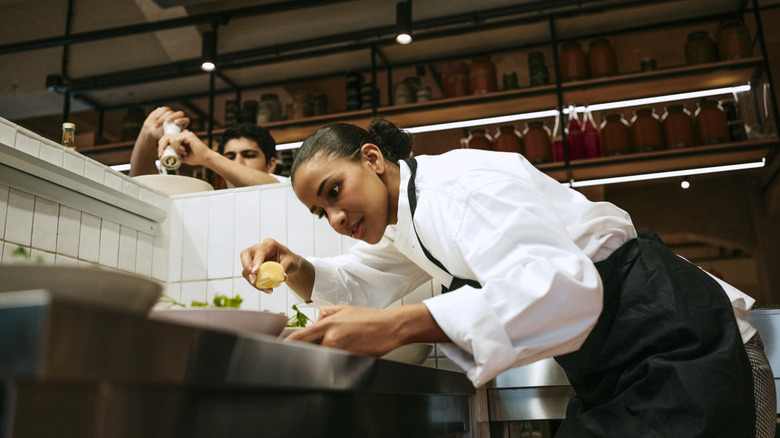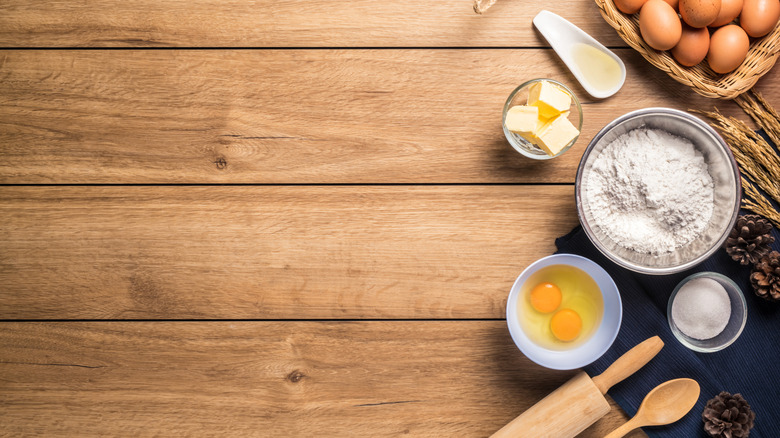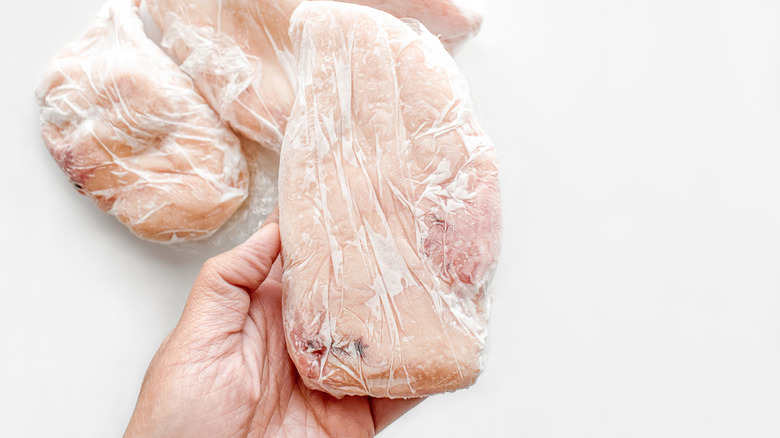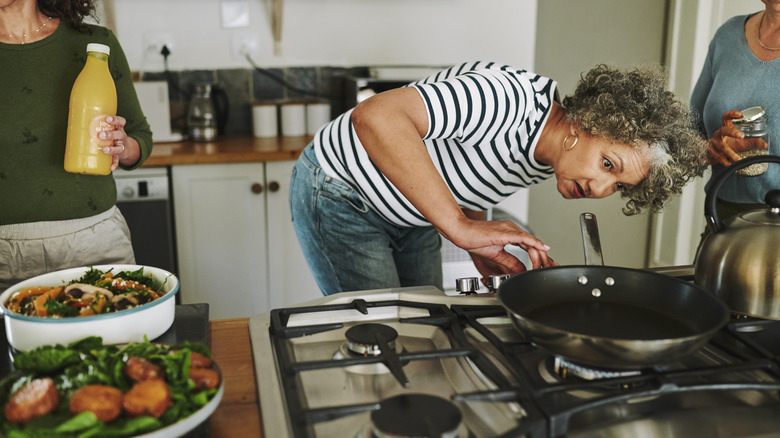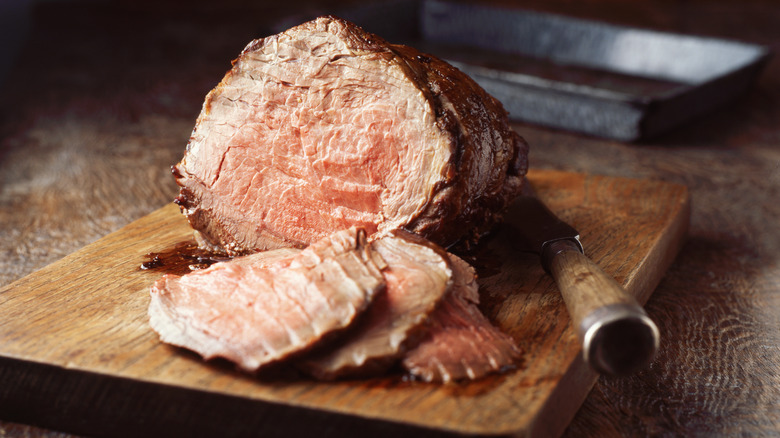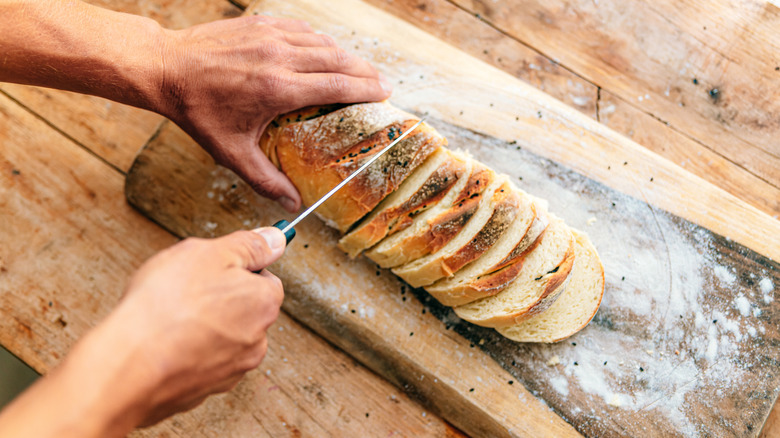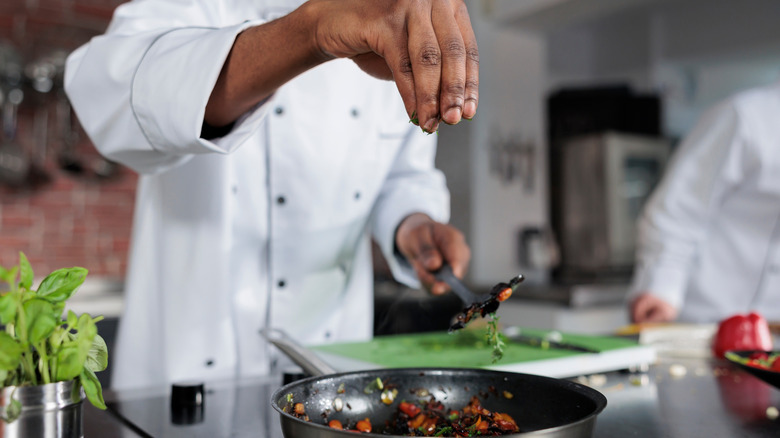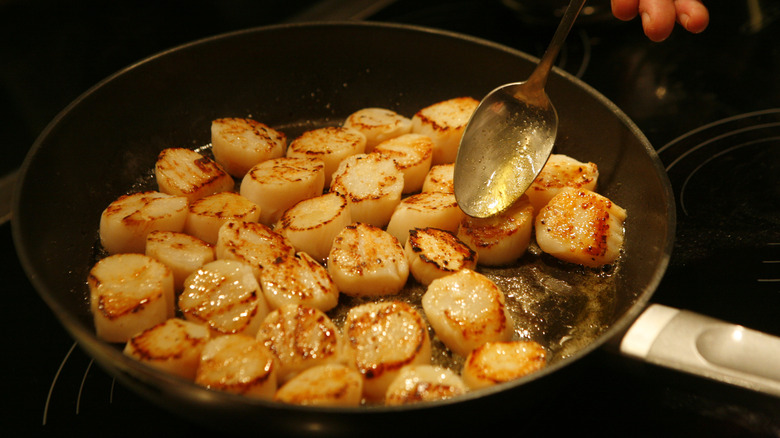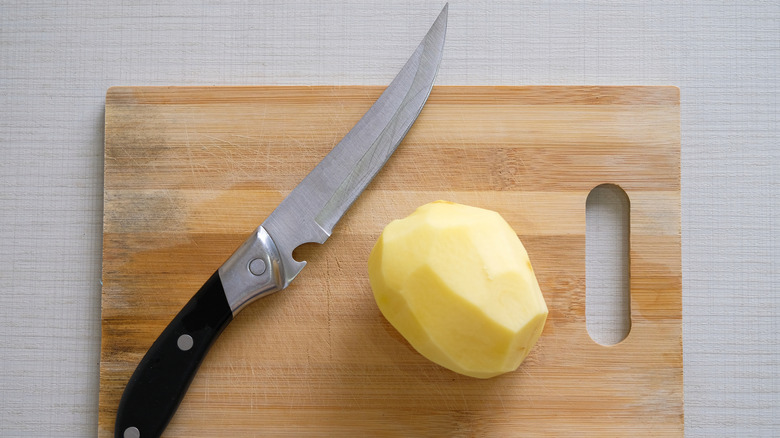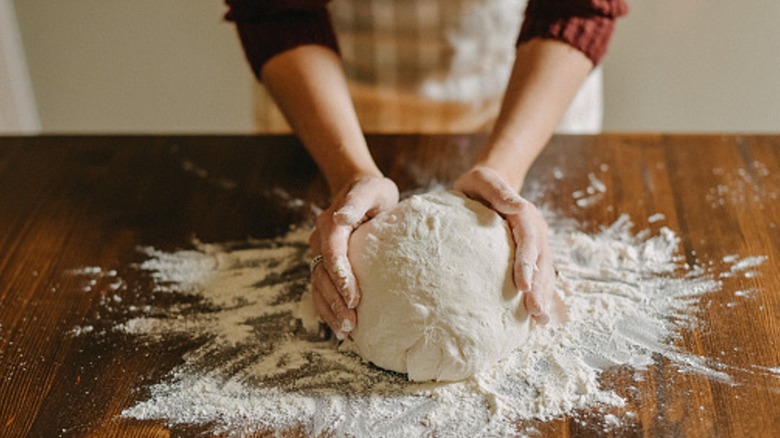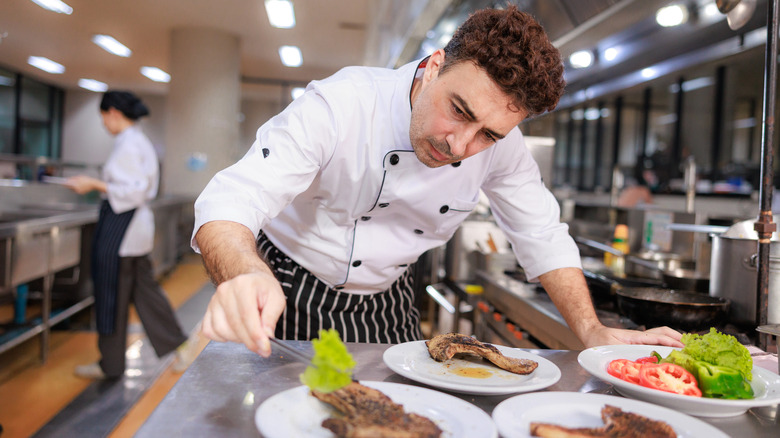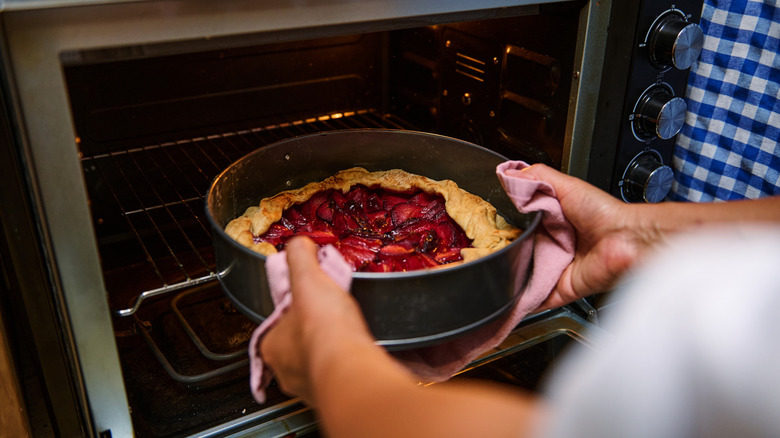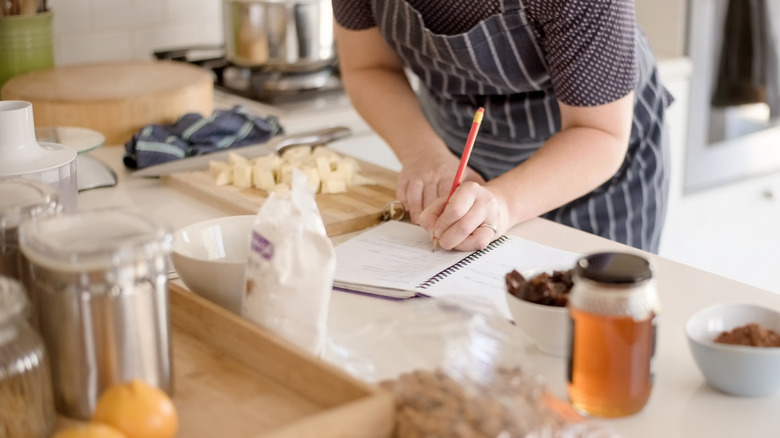Even Expert Chefs Make Cooking Mistakes: These Pros Admit Their Occasional Blunders
Many people spend a lot of time cooking in the kitchen. Some of us love experimenting with new recipes and preparing dishes to serve to family and friends. Others cook only because they rarely (if ever) dine out. Regardless of your feelings (and habits) about cooking, it isn't always the most simple thing and mistakes can happen that cause your food to turn out dry, burnt, lacking in flavor, or just off from what you were hoping for.
But, don't be too hard on yourself. Everyone makes mistakes in the kitchen — even the pros. We reached out to three professional chefs and asked them to share some mistakes even they're prone to making when preparing food. George Duran is a celebrity chef, comedian, and entertainer, Marcell Hatten is the executive chef at Gwen, and Joey Sergentakis is an executive chef and co-owner of three New Jersey restaurants: Boschetto, Allendale Social, and Charlie's Place. Let's learn about the cooking mistakes the pros sometimes fall victim to — you'll gain some first rate insight to help you steer clear of these situations.
Not prepping the ingredients before you begin cooking
Prepping the ingredients before you begin cooking can help make sure you have everything ready that you'll need for a recipe. If you've ever made the mistake of starting to cook without having all the important stuff prepped, you're not alone. George Duran, celebrity chef, cites this as one mistake professional chefs can often make. He says, "In busy kitchens, chefs sometimes assume they can prep as they go but end up miscalculating the time needed." This, he explains, can lead to other cooking mistakes or result in necessary ingredients being missed.
To avoid making this mistake, Duran recommends measuring and chopping the necessary ingredients before you actually start to cook. "I know it's tempting to just rush through, but being organized makes your cooking process 10 times easier," he says. Cross-reference the recipe that you are following to double-check you have everything ready — then you'll be able to actually cook without rushing around to grab an ingredient while something on the stove comes close to burning or boiling over. You'll find your stress levels go way down with some planning and preparation.
Forgetting to defrost ingredients ahead of time
Picture this: You just got home from a long day at work and are ready to start cooking dinner. You open the fridge to pull out the chicken or beef that you defrosted yesterday only to realize that you didn't actually take it out of the freezer? We've all been there — even the professionals. Joey Sergentakis, executive chef, highlights failing to pull items from the freezer as a mistake chefs make too, and he explains that it has the possibility to delay their production by a day.
Sergentakis says, "Proper defrosting requires planning ahead, as using warm water or leaving items out at room temperature is unsafe and can compromise quality." While you can potentially cook frozen chicken on the grill or cook other meats from frozen, doing so will alter the cooking times and the finished recipe won't taste the same. Instead, set reminders to defrost meat in the fridge the day before you plan on cooking it. In a pinch, you can try defrosting frozen meat in cold (never hot) water, but it will take a while and can still throw off your cooking times. If you're defrosting a large piece of meat, be sure to do your homework and research how long it takes to thaw items like a turkey in the refrigerator.
Skipping the preheat
"In stressful and high-paced environments, chefs might add ingredients before the pan reaches the right temperature," shares chef George Duran. Home chefs often make this mistake too, either due to rushing to get a meal cooked or not fully understanding the benefits of allowing a pan (or the oven) to preheat before cooking. Just because experts can make this mistake, you still want to try to avoid it in your kitchen.
Duran explains that food doesn't cook evenly when it's put in a cold pan or cold oven. The food can stick to the pan, end up overcooked in some sections, but overcooked in others, and may have a taste or texture that is less than desirable. "Always preheat the oven or pan for five to 10 minutes to ensure it's fully up to temperature. Use this time to prepare other ingredients," Duran recommends.
Failing to let meat rest before cutting it
Skipping the resting time is a mistake that many home chefs make when cooking the Thanksgiving turkey, a Sunday dinner roast, or other cuts of meat. Chefs Joey Sergentakis and George Duran explain that it is also a mistake some professional chefs make from time to time. "Properly resting meat is essential to ensure even cooking and retain moisture and flavor. In a busy kitchen, this step can be rushed, causing juices to escape and resulting in a dry or unevenly cooked protein," says Sergentakis.
The next time you prepare a roast, turkey, steak, or burgers, follow the advice of Sergentakis and Duran and allow it to rest for at least five to 10 minutes to give the juices time to redistribute themselves in the meat. "Tent it with foil to keep it warm if needed. Remember, it's almost like a meditative breathing exercise before you get into action. The meat needs that rest to shine on your dinner table," says Duran.
Not using the correct tools for the correct job
If you've ever been rushed or can't put your fingers on a specific tool that you need to serve or prepare a recipe, you might have just grabbed something else out of the drawer and tried to make it work. However, chances are, the substitute tool didn't work as well as the one that you really needed. Marcell Hatten can relate to this and notes that professional chefs can also be guilty of grabbing the wrong tool for a specific task.
"One great example of this is using a chef knife to cut bread when a serrated bread knife should be used so the bread cuts clean and even," he says. Just because you used the chef's knife for a different part of the recipe doesn't mean you should use it for a another task simply because it's right in front of you. Taking the time to pull out the tool you need will be well worth it. You won't struggle trying to fit a square peg into a round hole, for example, and you won't have to deal with the repercussions of using the wrong tool — which could include injuring yourself, ruining the recipe, or messing with the presentation of a cooked dish.
Under or overseasoning the dish you're preparing
Properly seasoning as you're cooking is essential. Under or overseasoning can cause mistakes whether you're preparing coleslaw, a roast, mashed potatoes, or spaghetti sauce. Yet, home chefs are not the only ones who sometimes struggle with seasoning. Marcell Hatten says, "Many chefs and cooks will greatly under season or not season all parts of their steaks, chicken, or fish. It's important to season liberally as you are not technically seasoning the 'inside' of the product."
However, take care not to go too far the other way and add too much seasoning. An overseasoned dish is going to turn off your taste buds and send guests home disappointed. George Duran, celebrity chef, cites rushing as a reason that both pros and home chefs may end up overseasoning a recipe. He says, "Season gradually, and taste as you go. Add salt and seasoning in layers, especially in soups and stews."
Overcrowding the Pan
"In a busy kitchen with all of the time pressures, chefs might rush to cook multiple portions at once," says George Duran, chef and former "Ultimate Cake Off" host. He explains this can lead to them overcrowding a pan and cooking too many items simultaneously. While it may seem more efficient to cook as many items at the same time as possible, it doesn't work that way. Duran explains, "Overcrowding lowers the pan's temperature, leading to steaming rather than browning, which affects texture and flavor." This can be a huge mistake when you're cooking scallops, for example, which prevents them from searing and caramelizing.
To avoid making this mistake at home, be sure to leave enough space between items in the pan to allow them to brown properly. Duran recommends cooking in batches if you are unable to leave sufficient space between the ingredients in the pan. While the extra time may seem like a hassle, the taste and texture of the finished product will be worth the effort.
Using dull equipment
When was the last time you had your knives and other slicers sharpened? If you've been cutting with dull equipment, then you're making a mistake that the professionals sometimes make as well. "Constant use in the kitchen can dull knives quickly, and chefs might overlook frequent sharpening during busy times," chef George Duran says. "Sometimes chefs don't realize their knives are dull until it's too late."
Believe it or not, using a dull knife to cut presents a bigger safety hazard than using a sharp one. With a sharp knife, you can more easily slice through what you need to cut. However, with the dull blade's inability to cut through the item with ease, it is more likely to slip. "This is especially dangerous as more force will be needed to cut or grate an ingredient. The slightest slip will result in an injury," explains Marcell Hatten, executive chef at Gwen. A sharp knife will also aid in presentation, as you'll be able to ensure more even slicing. And it's better to cut an avocado with a sharp knife as a cleaner cut reduces browning.
Ignoring seasonal variability
Did you know that the season can impact the way a recipe turns out or the various steps you'll need to take when preparing it? While professional chefs are more likely to understand how temperature changes can impact cooking methods than your average home chef, it doesn't mean they are immune to overlooking these impacts. Joey Sergentakis, executive chef and the co-owner of Boschetto, Allendale Social, and Charlie's Place, highlights preparing sourdough as one example of how the season can influence the best way to prepare a recipe.
He explains, "Making sourdough in July may require different techniques than in December. Adjusting methods to account for seasonal shifts is crucial for achieving desired results." When the weather is colder, you'll need to adjust your timeline as the dough will require more time to proof before baking. Failing to account for this difference could either throw off your schedule or cause you to bake the bread before it is fully proofed, resulting in an overly dense loaf.
Beyond being aware of the impact that temperature differences may have on your recipes, considering the current season can also help guide you toward selecting the freshest ingredients to use. Local fruits and vegetables can be harvested at the peak of their freshness, delivering the best taste and texture. They don't have to be picked earlier than is necessary in order to be shipped to a local grocery store. Find a local farmer's market and look for recipes that feature the fresh ingredients available.
Over-garnishing prepared meals
Professional chefs want their creations to impress their customers. According to executive chef Joey Sergantakis, this opens up the possibility of going overboard with garnishing the dish. "Overdoing it can clutter the plate, detracting from the main ingredients," he explains. While professional (and home) chefs want their recipes to look as good as they taste, too many garnishes can be a distraction. When combined with the rest of the ingredients, the garnishes may even detract from the original taste or texture of the recipe.
Instead, Sergantakis suggests keeping dishes simple to let main flavors come through. When garnishing, be very purposeful with where you place items. Don't put large handfuls of herbs or vegetables in a corner of the plate or over the main entree. Instead, sprinkle them over a small portion of the dish. Be sure to avoid adding any garnishes that have an overly strong flavor or aroma that could make the meal less enjoyable for anyone who is going to eat it.
Using a wet towel to grab hot items
While Marcell Hatten shares, "It is very important to have designated towels for dry and wet stations or locations," he also notes that some professional chefs don't always follow this important rule. In a busy kitchen, a chef may reach for a wet or damp towel to use to remove something from the oven.
The problem with using a wet towel (or wet pot oven mitts) is that it can make it more likely for the user to get burned. Many assume that the opposite is true and that the cold and wet cloth will protect their skin from the heat of the oven. However, when damp, a towel or oven mitt will offer less protection against the heat. Water conducts heat, so you can actually sustain a serious burn within a few seconds. Beyond the risk of burning your skin, using a damp oven mitt or towel can also make it more likely for the dish or pan you're removing to slip out of your hands. Play it safe all-around and follow Hatten's advice to use only dry oven mitts or towels when pulling cooked dishes out of the oven.
Inaccurate ordering and portion planning
Joey Sergentakis, executive chef, explains that professional chefs sometimes make mistakes when it comes to ordering ingredients. If they under-order, they can face a shortage and won't be able to prepare all the menu items their customers request. Over-ordering, on the other hand, can leave them with more food than they need, leading to unnecessary waste. To avoid such issues, Sergentakis highlights the importance of creating yield tests with different proteins so chefs can precisely portion their ingredients and know what to order. He says, "Knowing exactly how many portions can be obtained from items like a 20 pound whole salmon helps maintain consistency and control costs."
As a home chef, you aren't preparing recipes at the same scale a professional chef is. However, you still want to make sure you're preparing the ideal amount to serve the people in your home. You also don't want to end up with too much of an ingredient that goes to waste or realize you didn't buy a large enough portion of something to feed your entire household. Paying attention to portion sizes — and learning the best ways to freeze and preserve ingredients — can help you avoid some of these problems. Additionally, if you're using a more novel ingredient for a particular recipe, consider searching for other recipes you could use it with to avoid waste.
Failing to document your recipes
"In the fast-paced environment of a kitchen, it's easy to create a dish and move on without recording the recipe," says Joey Sergentakis, executive chef and the co-owner of three New Jersey restaurants. Professional chefs have a knack for coming up with creative ways to combine ingredients, which can result in a truly spectacular meal. However, if they don't write down the ingredients they used, even a pro might not be able to remake a successful creation. "Building a repertoire of documented recipes is essential for consistency, training, and refinement," explains Sergentakis. Professionals need a solid library of recipes they can share with others and work to continuously improve.
As a home chef, you likely experiment with different recipes and flavor combinations as well. Whether you "accidentally" land on a big hit as you try to use up some ingredients before they go bad or make a few small tweaks to a recipe you found online, you want to recreate your success the next time you're cooking these dishes. Create a recipe collection — with physical recipe cards or in an online folder — where you can write down the recipes you made and any modifications to the ingredient lists.
